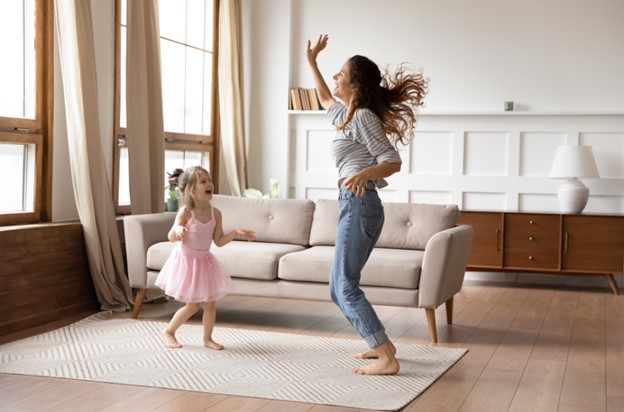
Our homes harbor an astonishing amount of indoor allergens and pollutants, from known culprits like dirt and dust, to pet dander, cigarette smoke, and more. But some of the most common are things you may not have thought of, like volatiles and combustion-related pollutants from cooking, toxic chemicals off-gassing from personal care and cleaning products, and molds.

AHAM recently sat down with Dr. Shelly L. Miller, Ph.D., an indoor air pollution expert and professor at the University of Colorado Boulder, to discuss all things indoor air quality (and portable air cleaners). During our conversation, she shared:
- The importance of ventilation for a healthy home
- Best practices for improving indoor air quality
- Things to look for when choosing a portable air cleaner
- How to get the most from your air cleaner
According to Dr. Miller, most homes are poorly ventilated. While being sealed up tight might be great for energy efficiency, it’s NOT great for indoor air quality. “Ventilation is critical for a healthy indoor environment. By bringing outdoor air inside, concentrations of indoor air contaminants get diluted,” she said.
Ventilation technology exists with things like heat recovery ventilators (HRV) or energy recovery ventilators (ERVs) that constantly condition and refresh the air inside the home, helping to remove pollutants, allergens, and other types of particles from the air. But, while modern ‘passive’ homes use these technologies, most homes — especially older homes — don’t have the technology, and it can be incredibly expensive to add.
Other than increasing ventilation, which, again, is a costly fix, Dr. Miller says, “Simple solutions do exist for improving indoor air in homes, businesses, and schools — with the best practices being source control and air cleaning.” Source control means removing the pollution at the source (such as using a range hood while cooking). Air cleaning, on the other hand, means capturing harmful pollutants after they have been released into the indoor air. This is where portable room air cleaners come into play. Portable room air cleaners represent a quick, accessible option for improving indoor air quality.
Once you decide to purchase an air cleaner, there are hundreds of models to choose from. Between learning about all the technical features, plus an abundance of acronyms like CADR, ACH, and HEPA that are associated with air cleaners, shopping for the right model can be confusing.
To determine whether an air cleaner will do the job, Dr. Miller advises to look for third-party certifications, and buy devices tested by the California Air Resources Board (CARB) and/or the Association of Home Appliance Manufacturers (AHAM) (That’s us! More on AHAM’s Verifide® program below).
Air cleaners are not one-size-fits-all solutions, and there are a few important things to consider when choosing a room air cleaner:
- Room size. It’s vital that the air cleaner is capable of effectively covering the size of the room in question. Always check the manufacturer’s specifications for the recommended room size.
- Focus on the Clean Air Delivery Rate (CADR). The CADR, which is AHAM’s standard for measuring an air cleaner’s efficacy, helps provide a way to choose an air cleaner based on your specific air cleaning needs. That’s because CADR is a measurement of how fast an air cleaner filters three commonly sized particulate matter: dust, pollen and tobacco smoke. Match your air purifier’s CADR to room size. To do that, follow AHAM’s recommended 2/3 rule, and choose an air cleaner with a dust, pollen, or smoke rating that is two-thirds the size of the square feet of the room. That means a room that is 200 square feet would require an air cleaner with a CADR of at least 132. If you live in an area with a high pollen count, consider air cleaners with higher ratings for filtering pollen. If dust is an issue, pay closer attention to the unit’s rating for dust. And if you have smokers in the home, look for higher ratings for smoke. The higher the CADR number for each pollutant, the faster the unit filters the pollutant from the air.
- If wildfire smoke is your concern, the room sizing recommendation changes. Wildfires drive smoke and ash to very high levels, often requiring masking outdoors. Portable room air cleaners that will be used to mitigate wildfire smoke should have a smoke CADR equal to the room size.
Knowing your unit’s CADR can help you determine how many air changes per hour (ACH) it is capable of, or how many times all the air in a space is cleaned. The bigger the room, the more airflow you need to clean all the air in it.
The U.S. Environmental Protection Agency recommends looking for air purifier models that provide at least 4.8 ACH for the recommended room size to help improve your indoor air quality. A device labeled to provide 4.8 ACH in a 10’x 12’ x 8’ room can treat the air in a room of that size 4.8 times each hour. In general, according to EPA, a device with much higher ACH for a room is not recommended, as it provides minimal air quality improvements for higher energy use.
It is important to note that claims regarding ACH and CADR have not been substantiated unless the product has been tested to the ANSI/AHAM AC-1 test method through a program that third-party verifies products such as the ENERGY STAR program or AHAM Verifide.
When it comes to using air cleaners properly, a good rule of thumb is to place an air cleaner in each room. “It’s best to place the air cleaner close to the source of pollutants,” Dr. Miller says. “For instance, in a kitchen without an exhaust hood, put the air cleaner close to the stove.” Otherwise, air cleaners should be positioned as close as possible to the center of the room to maximize airflow. It’s also important to change the air cleaner filter regularly, according to the model’s use and care instructions.
ABOUT AHAM VERIFIDE
When you’re ready to purchase an air cleaner, always look for the AHAM Verifide® mark. Room air cleaners certified through the AHAM Verifide program have been rigorously tested by an independent laboratory to ensure the product will perform to the manufacturer’s product claims for the suggested room size. The AHAM Verifide mark can be found on product packaging.
To find AHAM Verifide® room air cleaners, use AHAM’s online searchable directory to locate the model that’s right for you.
Find a Certified Room Air Cleaner Here
ABOUT DR. MILLER
Dr. Shelly L. Miller is a Professor of Mechanical Engineering and faculty in the Environmental Engineering Program at the University of Colorado Boulder, holding an M.S. and Ph.D. in Civil and Environmental Engineering from University of California, Berkeley, and a B.S. in Applied Mathematics from Harvey Mudd College. Dr. Miller studies urban air quality and works diligently to understand the impact of air pollution on public health and the environment. She is an expert on indoor air quality, airborne infectious disease transmission, air pollution and air cleaning technologies, and assessing and mitigating urban air pollution exposures in underserved communities. Dr. Miller is a member of the Academy of Fellows of the International Society for Indoor Air and Climate (ISIAQ) and is also an Associate Editor for Environmental Science and Technology. Dr. Miller has published over 100 peer-reviewed articles on air quality including timely papers on COVID-19 transmission and control, and is the principal investigator on the National Science Foundation’s Social Justice and Environmental Equity Project in Denver (SJEQDenver.com).




